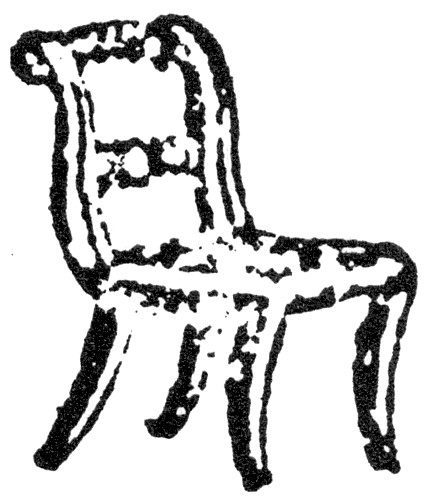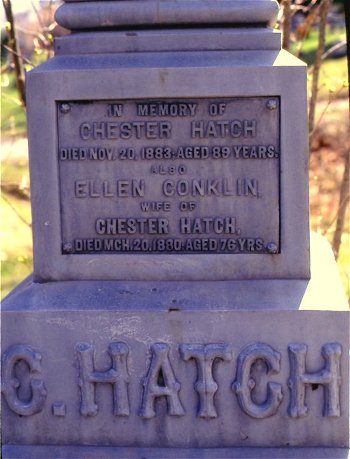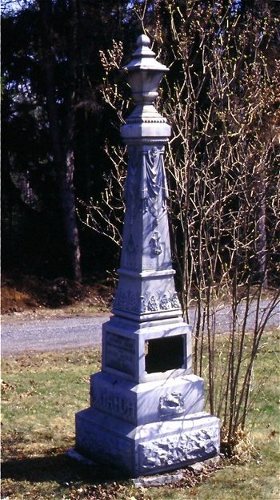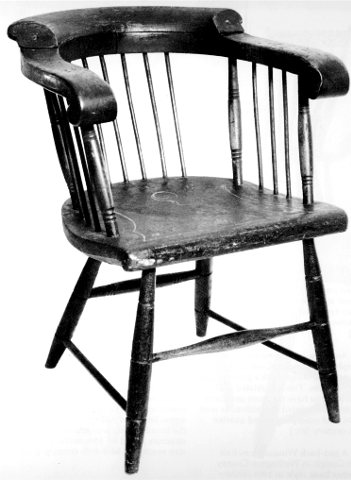|
CHAIR MAKER, 1794 -1883 active in Kingston, Ontario, 1815 - 1857 by Jennifer McKendryİ |
|
chair from 1828 advertisement for Hatch Chair-making was one of the early specializations of furniture - making. In the 18th century, Windsor chairs or ‘stick-construction’ was adapted to a type of mass - production — the components of the chairs could be made in quantities and then assembled. There was a tendency to keep chairs in stock for the customer to select, rather than executing custom designs, as in the case of beds or chests. Kingston had an early chair-maker, Chester Hatch, whose ambition and industry permeates the references to him in the local newspapers and documents. Born in 1794 in the United States and presumably trained there, he emigrated with his relatives in 1815. Only 21 years old, he speaks with authority in his first advertisement: “Elegant Fancy CHAIRS of the first quality, Kept Constantly on hand, and for sale by the Subscribers, at their Shop, near the Sign of the Fiddle, Kingston, where Ladies and Gentlemen will do well to call and examine for themselves, CHESTER HATCH & CO.” (Kingston Gazette, 19 Sept. 1815) Since the other Hatches, presumably his parents and brothers, were still living in one-storey log and frame houses in the mid-19th century, one wonders where the money came from to finance this venture and who the “company” was. A month after his first advertisement, Chester specified his interest in painting: “PAINTING. All Kinds of Ornamental Painting, gilding, and Varnishing done with neatness by the subscriber, at his shop over Mr. George H. McLean’s store; all persons wishing to have Sleighs, Signs, Chairs, etc., painted, must call within three weeks from the present date, as he will take in no work after. Copal varnish, and some other articles in his line for sale. CHESTER HATCH 1815”. He had evidently needed to diversify from chair-making, and clients might wish, to have their sleighs and older chairs brought up-to-date with fashionable painting. He had decided to move from George McLean’s premises, and perhaps that is why he h to limit the amount of work received. At this early stage in his career, clients may locate him by referring to a better-known merchant, such as McLean, but it will not be many years until younger merchants refer to the Hatch’s establishment as their landmark. By February of 1816, he is advertising from his new location: “CHAIR STORE. The Subscribers have removed to the Sign of the White Bear, where they intend to keep on hand a variety of CHAIRS, of different patterns — they in tend continuing business if the public encourage them sufficiently. C. HATCH & CO.” That rather plaintive appeal apparently. paid off, because by the next month a more confident ad appears: “CHAIRS. The Subscribers keep constantly on hand, in their Shop, at the Sign of the White Bear, a variety of Waterloo, Windsor, Rock and Children’s Chairs, ALSO BUREAUS for Sale. Shop Painting, likewise, done by C. HATCH &.CO.” One might speculate that Chester’s key to success was his flexibility, necessary in a town of modest size, and his recognition of current trends, necessary with the fickle tastes of the people who could afford to patronize him. Competition from other woodworkers, both locally and in the larger centres of Montreal and the United States, no doubt also kept up his awareness. Hence we find him advertising ‘Waterloo’ chairs, soon after the 1815 defeat of Napoleon. This was the new name for the splayed, concave legs, also called sabre of scimitar, of the Greek klismos chair, revived during the Regency period in Europe. “CHAIR SHOP. The Subscribers having removed to their new shop, would inform the public that they will endeavour in future to keep on hand all kinds of CHAIRS, SETTEES, etc., in their line. Ornamental Painting, Gilding and Varnishing done with neatness. Glass cut to any shape required. ALSO — boiled linseed oil for sale by the Barrel or smaller quantity — Paints ready prepared for use, and all directions for using them Gratis. C. HATCH & CO. 1816.” He has now added bureaus and settees, as well as glass-cutting, to his business, but the main emphasis will remain on chairs. These advertisements should seal the demise of two favourite and conflicting myths of the amateur antique collector: firstly, that furniture was ex posed to the raw wood, now produced by scraping off “Ornamental Painting” and, secondly, that old paint was always made of butter or skim milk and the blood of an unfortunate ox. In 1817 and 1818 he offers the following types of chairs: elegant, broad-top, ball-back; fancy and Windsor bamboo-turned; fancy and Windsor slat-back; real cane seat; Waterloo; Common (probably ladder-back); Rocking and Children’s. These, he assures the public, are WARRANTED GOOD and are “superior to any they have hitherto offered for sale”. The latter statement one would think would hardly be encouraging to their old customers, but Hatch was out to hustle business and noted that he would accept country produce for payment. Cash was sometimes difficult to collect due to a scarcity of coinage. Cabinet ware could also be purchased from the Princess Street Store under the same conditions. After the year 1818, he ceases such a heavy advertising campaign, probably because he was so well established by now that it was no longer necessary. Other merchants start to advertise that they sell their products “opposite Mr. Hatch’s Chair Store” etc. By the time that he is 27-years-old, he has opened a branch in Toronto. There he offers a constant supply of Bamboo and Windsor chairs, Fancy and Windsor Settees, and Sign and Fancy Painting, and “hopes by the Superior quality of their work and Strict attention to Business to merit a share of Public Patronage”. (Upper Canada Gazette, York, 21 August 1823) However, his loyalties are with Kingston and he marries a local girl, Ellen Conklin (1804-1880), in 1825. She was 21 years old, and over the next 19 years would bear him six. children. Their eldest son, Wilson, was born in 1826 and in the 1840s is noted as a Chair Maker of the town of Kingston. In 1849 he advertised: “CITY CHAIR FACTORY. Wilson Hatch will sell at wholesale, 10 per cent cheaper than any importer”. This brief notice indicates the stiff competition individual furniture makers were feeling from the large factories of Britain and the United States. The era of local production catering to local tastes, in which Chester had started his business, was drawing to an end in the Victorian period. However, with earned smugness, Chester could report to the census-taker of 1861 that he was a “Modern Gentleman” who lived in a three-storey stone house with his wife, Ellen, and four of his six children. His sons, Wilson and George, were away in California, presumably seeking their fortunes. An Irish servant and three men lived with them in the house and five-storey stone shop, now rented out to various tradesmen. Chester had retired in 1857 (reported in the 1861 census), and could report that in his 42-year career, he had had an annual manufacturing of 4,500 chairs. In 1816, a youthful Chester hoped that the public would sufficiently encourage the company to continue and, by 1853, Chester, a middle-aged, charitable, Congregationalist businessman, was voted in as a member of the recently formed Board of Trade whose selected members represented the successful entrepreneurs of mid-19th century Kingston. Chester Hatch “reached a ripe old age, 89, and died with the respect and love of all who knew him,” according to the Daily British Whig upon learning of his death on 20 November 1883 in his son’s house. He is buried in Cataraqui Cemetery. It is a fitting tribute that – despite the passage of over a quarter of a century since he had retired - the newspaper remembered him “as a chair maker [who had] a thriving business.”
Monument of cast zinc for the Hatch family, 1883, Cataraqui Cemetery, photos by Jennifer McKendryİ
right: Low-back Windsor armchair, stamped Hatch, from Kingston, and illustrated in Howard Pain's The Heritage of Upper Canadian Furniture (1978) as number 252. See also figures 281 (arrow-back sidechair), 372 (sidechair with woven seat), and 743 (Windsor cradle).
On pages 76-7 and page 123 of Joan MacKinnon's Kingston Cabinetmakers, 1800-1867 (National Museum of Man Mercury Series, History Division Paper No. 14, 1976), a Hatch arrowback sidechair, a "chickencoop" sidechair and a cane-seat sidechair are illustrated. Further details on Hatch's life are described in this book.
home page top of page antiques (list of internal links to articles on antiques) |



